
June 2021
Dislocated Worker and Federal Adult Programs
PY20 data freeze date:
- July 9, 2021. This means, all data you’d like included in the PY20 annual reports (state and WIOA) will need to be in the system by COB 7/9/2021.
- The main area to concentrate on is Measurable Skill Gains; every participant that attended training at any time during the program year (07/01/2020 – 06/30/2021) must have at least one MSG on their record during that same time or it will be a negative in the MSG measure.
- Please reach out to Amy Carlson for questions.
NEW Workforce One Questions (relating to new DWGs):
- New Questions on WF1 – “Do you, family, friends have a history of opioid abuse?” this question is voluntary, but helpful for assessing if we need to scale the Opioid grant statewide.
WIOA DW, WIOA Adult, and State DW:
- PY19 allocations are closing on 06/30/2021. Please review performance article in the Partner Express (released on 5/10/21) for instructions on how to perform data entry requirements by the deadline provided within that article. If you have questions, please email Amy.Carlson@state.mn.us
- PY21 WIOA Adult and DW Planning documents were due to the DW team on Friday May 28th.
- State DW Formula Fund: Preliminary allocations will be available mid-late June
Minnesota Job Skills Partnership Board (MJSP) meeting:
- Scheduled for Monday, June 14, 2021; date may change based on legislative session**.
Carry Forward Requests:
- Providers may request a waiver to carry forward more than 20% of their allocated PY20 funds into the next program year using the provided template (link below). Providers who expend or obligate at least 80% of their PY20 formula funds by the end of the 4th quarter do not need a waiver.
- Please submit your waiver by June 7th to allow enough time for leadership approval.
- The request can be sent to any of the DW Grant Specialists or Supervisor.
Policy Update: Eligible Training Provider List and WIOA Certification for Training Programs Draft!:
- Now open for 30-day public comment period
-
Summary: The Workforce Innovation and Opportunity Act (WIOA) requires that every state maintains an Eligible Training Provider List (ETPL), which is administered by the Department of Employment and Economic Development (DEED). Local WIOA Title I service providers; interested, prospective, and participating Eligible Training Providers; Local Workforce Development Boards; and their partners should comply with this policy to ensure high-quality training experiences for customers of WIOA Title I programs.
-
Policy Link - https://apps.deed.state.mn.us/ddp/PolicyDetail.aspx?pol=565
RETAIN Phase II Grant:
- Minnesota RETAIN Phase II grant from the U.S. Department of Labor was announced at the end of April. This 4-year, $19.5 million grant has a goal of helping keep 3,200 Minnesotans connected to the workforce if they become ill or are injured. Minnesota was one of only five states to receive such a grant.
RETAIN Press Release: https://mn.gov/deed/newscenter/press-releases/?id=1045-479890
Dislocated Worker and WIOA Adult Performance Updates
IMPORTANT DATE: Program Year 2020 Data Freeze Date is scheduled for July 9, 2021. Please have all your data entry up to date including all Measurable Skill Gains (MSGs) achieved by your participants during the timeframe of 07/01/2020 – 06/30/2021 into Workforce One (WF1) no later than close of business 07/9/2021.
MEASURABLE SKILL GAINS: To assist local areas to confirm MSG achievements are captured within WF1 case details, a list of case records currently showing in the MSG denominator but do not yet have a MSG captured on their case will be emailed to local area management teams. The list will only include participants who had a WF1 training activity open on their case for at least 1 day during the program year (07/01/2020 – present date). That email will include the participant WF1 ID, the most recent date a gain was captured (if any), and instructions on how to capture the achieved gain in WF1.
Cases accessing Program Year (PY) 2019 Dislocated Worker (DW) and WIOA Adult (AD) Allocations
Reminder: PY2019 allocations will be expiring on June 30, 2021. All cases showing the following funding streams within an open activity will need your attention.
If the participant will continue receiving a service currently supported by PY2019 allocations after June 30, 2021, a new activity will need to be opened for each service the participant will continue.
Reminder: All Dislocated Worker and WIOA Adult program year formula allocations (small layoff grants/WIOA Adult allotments) remain active for two years.
- PY2019 Allocation = July 1, 2019 – June 30, 2021 (EXPIRING)
- PY2020 Allocation = July 1, 2020 – June 30, 2022
- PY2021 Allocation = July 1, 2021 – June 30, 2023
This means, the new activity will need a PY2020 or PY2021 formula grant selected within them depending on your agencies budget.
Important Information to Know
- All activities with a PY2019 allocation selected within them cannot have a start date after June 30, 2021 and must have an end date no later than June 30, 2021.
- If any participant will continue participating in an activity that is currently showing a PY2019 allocation supporting that service, that activity needs to be copied within their activity detail screen.
- The new activity will need a start date of July 1, 2021
- An active funding source (PY2020 or PY2021) will need to be selected within them.
- To help in this funding source transition
- Amy Carlson will mass close all currently open PY2019 funded activities with an end date of June 30, 2021, which means you will only need to open/copy the old activities. If you want to close the old activities yourself, that is fine. If you choose not to close them yourself, it will be taken care of for you.
- This mass activity closure will begin August 1, 2021.
- If there are cases without other open activities on record showing a different funding source, this mass closure will not work for those cases. Any cases that show they cannot be included in the PY2019 funded activity closure will be emailed to the management team for the COFFR funding the case.
- Shortly after July 1, 2021, additional funding streams will be added to your dropdown lists for PY2021 allocations. The date these new funding streams will be available is dependent on when PY2021 contracts are in place. Your management teams will be alerted as soon as your agency’s PY2021 funding streams are available in WF1.
Guidance on Specific PY19 Funded Activity Scenarios
Question: What if training was fully funded by the PY19 grant but the participant will continue attending that training after 06/30/2021?
Answer: Make note of all cases that fall into this scenario.
- Copy all other activities that will be funded by a different grant after 06/30/2021. Do not copy the training activity since a different grant will not be supporting it after 06/30/2021.
- Once the mass closure of PY19 activities is completed (by 08/16/2021), the assigned staff will need to go back into each of the cases with this scenario and remove the end date from the training activity by clicking “edit” next to that activity within the WF1 record
- The training activity will later be closed with the last date the participant attends that training
Question: Are we supposed to copy Employed, Pending Exit and Pending Exit, Other activities for the PY19 closure?
Answer: No, do not copy these activities because after the 90 days of no service exhausts (holding period these activities represent), the activity end date and exit date will be retroactive to the start date of this activity, which will be during the PY19 grant period.
Reminder, whenever these activities are open, no other activities should be open at the same time since these activities represent no services being provided. (Any open activities would contradict this since all other activities represent services being provided.) If there are no other open activities on the case, Amy Carlson will not be able to close out these activities. It is likely that after the mass closure, cases with these activities will be on the spreadsheets emailed to local area management teams as cases where the mass closure could not close activities. (Hopefully, the only cases on those spreadsheets are cases with these activities)
Special situation if the participant returns for a service other than a follow-up service you will then need to update data entry like normal in order to capture the new last date of service…
- Close the Employed, Pending Exit activity with the date of 06/30/2021
- Open an activity that best represents the service provided to the participant when they returned with the date of 07/01/2021 and the funding source used to support that service
- Open a new Employed Pending Exit activity with whatever the new last date of service is and the funding stream that supported that last service
- Close the activity that represents the last service provided with the same date as the new Employed, Pending Exit activity
- Follow the normal exiting procedure after 90 days exhausts from the new last date of service
Program Year (PY) 2020 Quarter Three (Q3) Performance Outcomes Compared to Negotiated Goals
Attached you will find the performance outcome spreadsheets for Total Dislocated Worker, State Dislocated Worker, WIOA Dislocated Worker, DWG, and WIOA Adult programs. These are best when printed landscape, in color, and on 11x17 size paper.
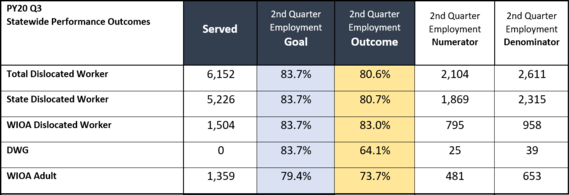 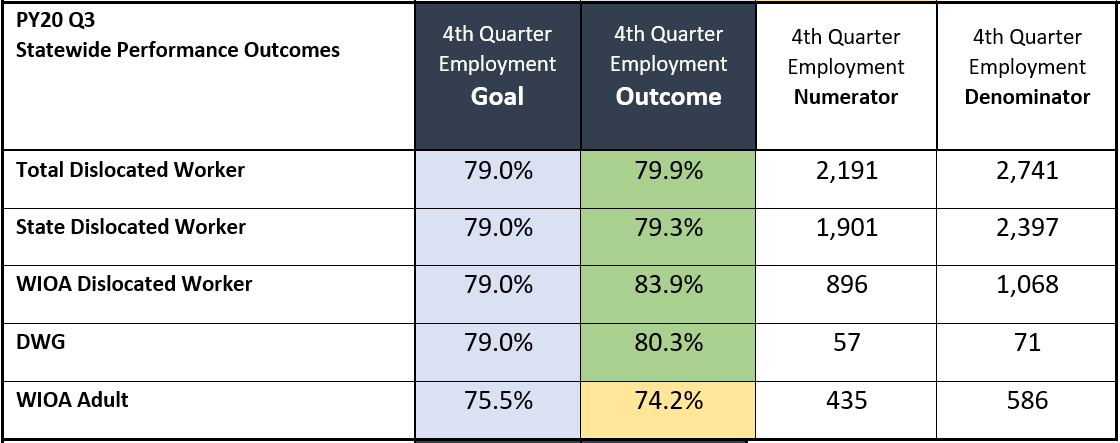 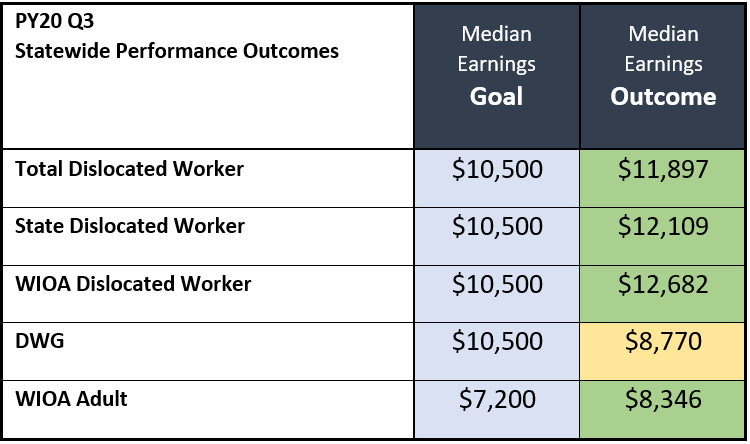 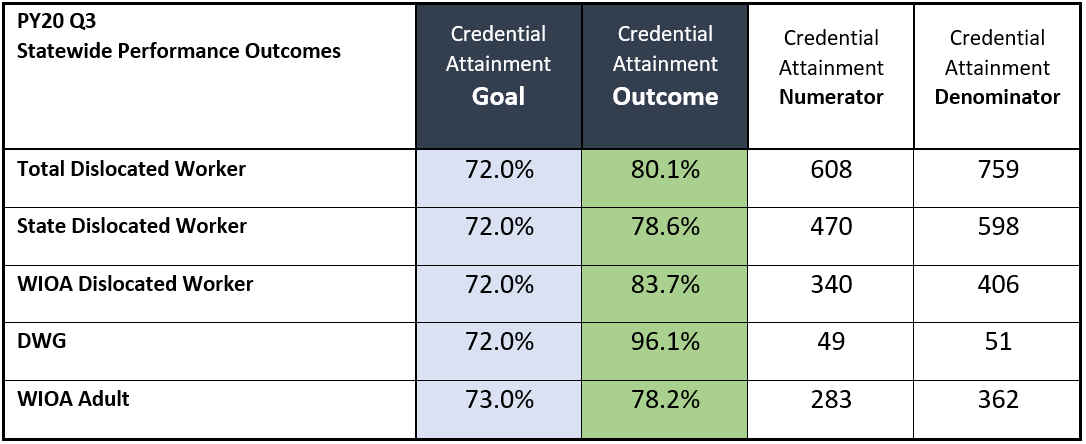 
- Performance goals based on WlOA negotiated standards for PY2020
- Color Key:
- Blue are the negotiated performance standards
- Green means the set goal was met or exceeded
- Yellow means at least 50% of the goal was met
- Red means less than 50% of the goal was met
- Served is all participants accessing the program during the actual program year (real-time)
- Getting a Job results based on program exits July 1, 2019 – March 31, 2020 except those exited with exclusion. This indicator measures each exiter's employment status during the 2nd quarter after exiting the program. Formula: Percent of employed exiters divided by all exiters during the reporting period.
- Keeping a Job results based on program exits January 1, 2019 – September 30, 2019 except those exited with exclusion. This indicator measures each exiter's employment status during the 4th quarter after exiting the program. Formula: Percent of employed exiters divided by all exiters during the reporting period.
- 2nd Quarter Median Earnings results based on program exits July 1, 2019 – March 31, 2019 except those exited with exclusionary reason and those showing zero earnings. This indicator measures the median earning during the 2nd quarter after exiting the program.
- Credential Attainment results based on program exits January 1, 2019 – September 30, 2019 except those exited with exclusionary reason and those who did not attend credential type training. This indicator measures the percent of participants who received a credential after attending training.
Should you have any performance or data entry questions, please contact the Federal Adult Programs Performance Coordinator, Amy Carlson, at amy.carlson@state.mn.us.
Adult Career Pathways (ACP)
The ACP Team would like to introduce Jenilee Drilling as our new Grant Coordinator! Jenilee comes to DEED with lots of workforce development experience. We are excited to have her join the team!
Legislative Direct Appropriation Grants/Competitive Grants SFY20/21
- State Legislators have begun meeting and the ACP team is watching closely as the final budget will determine SFY22-23 program budgets. We expect RFPs to be released summer 2021.
- The ACP Team released the Minnesota Tech Training Pilot Project RFP March 11th, with a due date of Friday April 30th. This is a new program within ACP serving adults 18-30 and targeting underrepresentation of BIPOC communities in the Technology field.
- Sign up to receive notices about open DEED RFPs at: https://mn.gov/deed/about/contracts/open-rfp.jsp
SNAP E&T 50/50
The ACP team continues to work with our eight SNAP E&T 50% Reimbursement Grantees for SFY21 providing 50% reimbursement on expenses already incurred through ACP’s Pathways to Prosperity and MN Family Resiliency Partnership (DHP) programs.
MN Family Resiliency Partnership (formerly known as Displaced Homemaker Program)
What is a Displaced Homemaker?
“A displaced Homemaker is an individual who has spent a substantial number of years in the home providing homemaking services and
- i) has been dependent upon the financial support of another; and now due to divorce, separation, death or disability of that person, must find employment to self-support,
or
- ii) derived a substantial share of support from public assistance on account of dependents in the home and no longer receives such support.”
Participants must also meet Income guidelines (at or below 200% FPG.)
More information about the Minnesota Family Resiliency Partnership program can be found on DEED’s ACP webpage at https://mn.gov/deed/job-seekers/find-a-job/targeted-services/homemakers/.
Workforce One User Guide
The ACP team is working to update the ACP Workforce One Guide to reflect updates and changes to programs in the past two years. Stay tuned for the updated guide!
ACP Operations Guide
ACP’s Operations Guide is now available from the ACP home page. The Guide documents current practices for ACP. The ACP Team meets monthly to discuss suggested additions, modifications, and other changes to the guide and update as necessary. It does NOT include measures implemented in response to COVID-19, which are listed separately.
Program Guidance
Timing of enrollments
The ACP Team would like to remind Grantees that the timing of your enrollments can have an impact on the outcome measurements. Enrollments into ACP programs in WF1 must be intentional with the timing of enrollments after an assessment has been conducted and the proposed training has been determined to meet the participant’s employment goal.
Employment Placement Verification
Grantees exiting participants to Entered Unsubsidized Employment or Employment must include verification of employment (i.e. pay stub, offer letter, employment verification form or another verifiable document from the employer) in the participant’s file and/or uploaded in to WF1 EDS. Please refer to the “Exits” section of the ACP Operations Guide for more information.
Trade Adjustment Assistance (TAA)
Staffing Update
- Laurie Larson, TAA Specialist, has accepted a position with the Department of Transportation. She has been on the TAA team for about six years. Laurie’s last day with TAA was May 25.
- Laurie’s caseload was distributed among the other TAA Specialists. WF1 Case Assignments are current.
Training Progress Reports are required year-round, even during breaks in training
- A customer who completes the spring semester of training and is returning in the fall, but not attending summer classes, still needs to submit a Training Progress Report (TPR.) The Training Progress Report is required every 60 calendar days regardless of breaks in training.
- TAA recognizes there will be no instructor signatures as the student is not in class, but a school official, registrar, or advisor should complete the top portion (answer questions and sign and date) along with completing the instructor section stating “break in training” or “not attending summer” then sign and date.
- Ideally, the student would submit the form before the school term ends, although it may be fewer than 60 days from the last Training Progress Report.
- Completing a Training Progress Report while not attending summer classes may take more effort, but it is still required.
Roundtables
Minnesota TAA hosted virtual Roundtables for Dislocated Worker Counselors April 13-15, 2021.
Reversion and Sunset Clauses
Blog from U.S. Department of Labor (DOL) re: Reversion and Sunset Clauses of the 2015 TAA Program
Minnesota TAA will follow Department of Labor’s guidance for continued guidance and planning.
Reversion 2021: Without Congressional action, on July 1, 2021, the TAA Program will revert to a modified version of the Trade Reform Act of 2002. Any workers covered under a Petition for Trade Adjustment Assistance filed on or after July 1, 2021, would be covered by this modified version.
Sunset Provisions: Again, this is only if no Congressional action is taken. The TAA Program will sunset (expire) on June 30, 2022. No additional Petitions will be accepted after that time. No additional funding will be awarded after June 30, 2022. Unexpended funds from previous, but active, fiscal years will still be available for expenditure subject to any restrictions explained in the Operating Instructions.
Trade Adjustment Assistance (TAA) Petitions
Here’s the link to check the status of petitions with U.S. Department of Labor https://www.doleta.gov/tradeact/petitioners/taa_search_form.cfm
- Recently certified
- 96880 – Ascension Technologies (Health), St Louis, MO (workers in Minnesota)
- Recently denied
- 96651 - DeCare Dental, LLC. a subsidiary of Anthem Companies, Inc., Eagan
- Pending DOL’s investigation
- 96906 - The Mosaic Company, Minneapolis
- 96905 – Vervent Inc., Laverne
- 96901 – Bedford Industries, Worthington
- 96890 – Teleflex, Maple Grove
- 96860E – Synchrony Bank, Saint Paul
Mirroring TAA Activities
Due to recent reporting changes/updates for the DW program, please see updated guidance below. This guidance is current as of 4/29/21 and replaces all previous guidance provided by MN TAA regarding mirroring activities.
It is highly recommended that DW providers open a corresponding training activity when a TAA training activity is opened. For example, when a TAA Specialist opens an Occupational Skills Training activity, the DW counselor would open a Classroom Training activity with the same information in it as the Occupational Skills Training activity.
- If there is not a corresponding DW training activity on the case, the DW performance report will not count the participant in the credential measure
- If there is a corresponding DW training activity on the case, the DW performance report will count the participant in the credential measure
| Activity Entered by TAA Staff |
Corresponding DW Mirroring Activity |
| Occupational Skill Training |
Classroom Training |
| OJT |
OJT Public or Private |
| TAA Apprenticeship |
Apprenticeship |
| Waiver |
Career Counseling |
ETPL Administration and Monitoring
ETPL Policy Open for Public Comment
We are in the midst of a 30 day public comment period for revisions and increased transparency for the ETPL’s training providers. The updated policy can be found here: https://apps.deed.state.mn.us/ddp/PolicyDetail.aspx?pol=565
In practice, documentation for credential attainment is the same: In the Education Explorer Search Tool there either needs to be a “Yes” under the “WIOA Certified” column (making it WIOA Certified/Classroom Training), or a “Yes” under the “Non-Credential Training” column (making it Non-Credentialed Training).
If a Training Institution or Educational Offering is listed on the Education Explorer Search Tool, but it does not have a “Yes” under either of those columns, or it says “Pending or not yet requested” that offering is not eligible for funding at this time. “Pending or not requested” is a training that needs to be reviewed by ETPL Administration due to being a new program or from having training details changed that may impact WIOA eligibility.
If a training shows as ‘pending…’ please email ETPL Administration and we can complete a review to get the training beyond pending status. ETPL Administration’s email is: etpl.deed@state.mn.us.
Minnesota's API for Credential Transparency is now Live
This project automatically populates information about Minnesota’s training programs into the Credential Finder. This easily comparable national platform increases the ability of the public to explore credentials, learning opportunities, training, and career pathways.
Minnesota’s contribution to the online registry establishes national awareness of training opportunities for career seekers and employers. It validates Minnesota-based education and skills, increases interoperability of Minnesota’s credentials via common language for degrees and microcredentials, and builds awareness of strategies for successful career growth.
Check out Minnesota’s programs in the national tool here: https://credentialfinder.org/organization/1356/Minnesota_Department_of_Employment_and_Economic_Development_(DEED).
This work was made possible by Credential Engine, Minnesota State Colleges and Universities, Minnesota’s Office of Higher Education, DEED’s Performance and Technical Management Team, the Minnesota Job Skills Partnership, and Minnesota IT Services.
Labor Market Information
By the Numbers
From March 2020 to March 2021, 786,617 Minnesotans eligible for Unemployment Insurance (UI) filed for benefits. This represents 26% of Minnesota's workforce, the staggering toll of the pandemic recession. A new article by Alessia Leibert presents early findings about Minnesota workers who were laid off during March through June of 2020 and the most up-to-date information we have about their employment status.
Specifically, the study considers:
- How many and which workers were brought back to jobs at their old employer;
- Those who continued to work second jobs;
- Those who found new jobs; and
- Those who continued to collect Unemployment Insurance (UI) benefits during the initial pandemic employment rebound in the summer of 2020.
The information about how different groups of workers fared is analyzed by part-time/full-time and regular/seasonal status, as well as by wage level, racial and ethnic background, industry and occupation.
The first key take-away from this analysis is the very large share of claimants, 59%, who were recalled by the same employer during summer 2020 (the first group in Table 1). Fewer broken bonds between employee and employer is good news for the recovery. During the first half of the year these workers had the second shortest spells of unemployment, a median of 7 weeks. However, not everyone in this group was able to return to stable employment. Thirty-three percent were laid off or furloughed again after September 2020 and it is still unclear whether they have been recalled or not. Only 21% of claimants did not return to work and continued to request UI benefits.
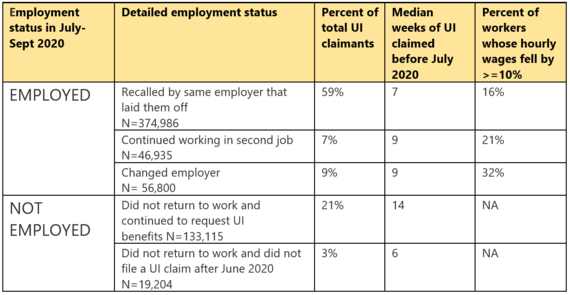 This analysis highlights the need to help workers laid off from industries where employment may recover more slowly move to higher demand industries that have a better chance of providing stable employment. It finds that the same challenges that hindered hiring pre-pandemic, including racial disparities and biases, skills gaps, location mismatch, less desirable work conditions and low-paying jobs continue and are in some cases exacerbated by conditions caused by the pandemic.
In conclusion, the evidence laid out in this study gives reason for optimism about a quick recovery, but also highlights the challenges of reskilling the workforce to enable mobility from hard-hit industries to high performing ones. Investments in retraining, both on-the-job and through educational institutions, and employment support services, including transportation and childcare, could give workers better tools to navigate future crises.
See the entire article Reemployment After COVID-19 Layoffs in Minnesota: Early Findings for greater detail and further analysis.
We want this e-Newsletter to meet your needs! We encourage you to send your comments, suggestions and subscription requests to deed.taa@state.mn.us. Find past issues of Partner Express.
|